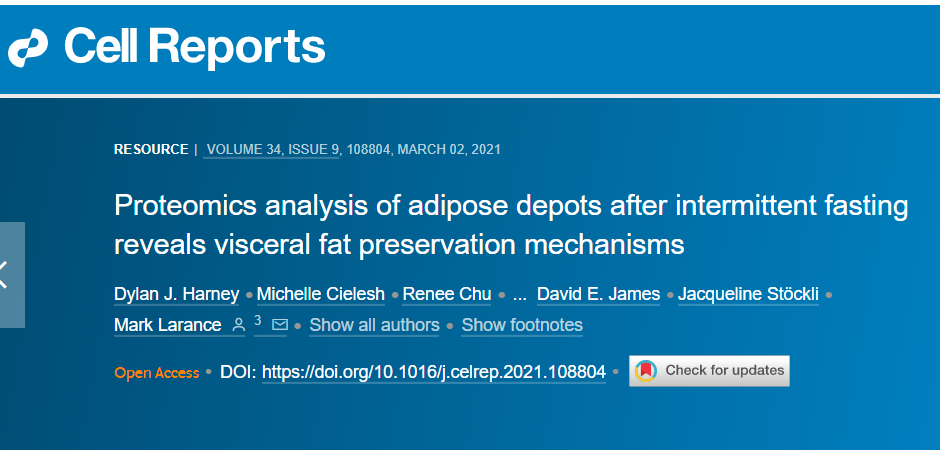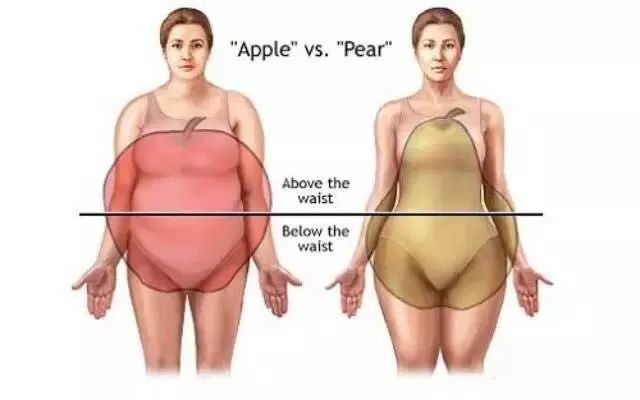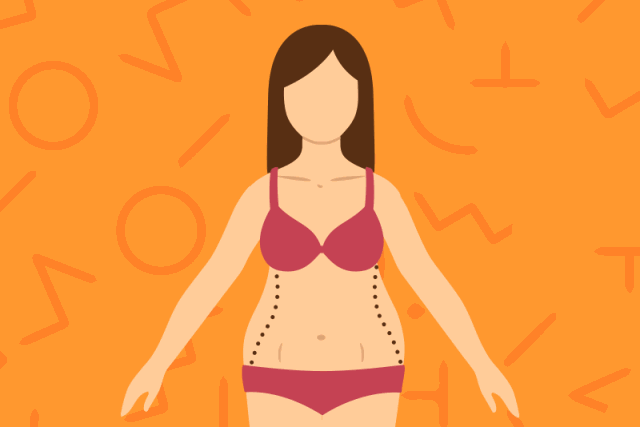
Everyone who has lost weight may have a question: Why is the meat on the belly so hard to lose?

In fact, the meat on the belly is not only difficult to reduce, but also more likely to accumulate. In addition, the “big belly” is more harmful to health than body fat or lower body fat.
For people of this type, body fat accumulates around the abdomen and internal organs. Visceral fat easily enters the bloodstream in the form of free fatty acids and flows to the heart, lungs and arteries, thereby inducing cardiovascular disease. When losing weight, visceral fat is struggling.” resistance”

On March 3, a research team from the University of Sydney published a new study in Cell Reports (a sub-issue of Cell), saying that they used proteomics technology to find that abdominal fat (visceral fat) is in the body It accumulates into a “big belly”. Over time, these fats can change their storage mode and adapt to the fasting state, thus having stronger resistance to weight loss. It turns out that belly fat is the “fighter” in fat.
Clinically, according to the characteristics of fat distribution, obesity is mainly divided into central obesity (abdominal obesity) and peripheral obesity.

Central obesity: Apple-shaped body
Visceral fat increases, and fat accumulates in the abdomen, forming an apple-shaped body. Such people usually have small arms, legs, and big belly, but the waist and abdomen are round. Such people have a higher incidence of hypertension, diabetes, coronary heart disease, and stroke.
Peripheral obesity: pear-shaped body
What is increased is subcutaneous fat, which accumulates in the buttocks, forming a pear-shaped body. Fat is mainly deposited on the buttocks and thighs. The upper body is not fat and the lower body is fat. This type of obesity is relatively less likely to cause complications.
If you want to judge whether it is abdominal obesity, you can use the waist-hip ratio to measure it, that is, the number obtained by dividing the waist-to-hip number by the hip-to-hip number (waist-to-hip ratio=waist/hip).
The ideal waist-to-hip ratio for men is 0.9 or less, and the ideal waist-to-hip ratio for women is 0.8 or less. Even if it exceeds the standard, it is an apple-shaped figure.
Why is belly fat easy to accumulate?

Eating habits
Three meals are irregular, one is hungry, one is full, and when dinner is over, there will be big fish and overeating. These bad eating habits can easily lead to excess energy and cause abdominal obesity.
In addition, people who like to eat high-energy, high-sugar, and high-fat foods will make their belly bigger and bigger if they consume more calories than the body needs.
Sedentary
Food intake is high, the amount of exercise is low, the energy consumption is low, and the blood circulation in the waist and abdomen is poor, fat is easy to stay, and the fat accumulation is excessive over time.
Gender factor
The waist and abdomen are among the various parts of the human body, one of the most prone to accumulate fat. Generally, men’s waist and abdomen are more likely to accumulate fat, while women’s buttocks, lower abdomen and waist accumulate the fastest, and finally the limbs.
Lack of sleep
Lack of sleep can lead to a decrease in leptin and an increase in hunger hormone, leading to an increase in appetite. According to data analysis by the Korea Food Research Institute, people who sleep 7 to 9 hours a night have a 28% to 35% lower risk of abdominal obesity than those who sleep less than 5 hours a night.
Belly fat hurts you like this
There is a lot of visceral fat. The typical feature is a big belly and thin limbs. The beer belly and general belly we usually talk about are all abdominal obesity. The accumulation of abdominal fat is quietly causing a series of damage to the whole body:
Fatty liver
Too much visceral fat can easily cause fatty liver. Fatty liver is reversible in the early stage, and ignoring it will increase the risk of liver cancer.

Diabetes
The risk of diabetes for obese people is 3.7 times that of normal people, and the risk of diabetes for people with abdominal obesity is 10.3 times that of normal people.
Hyperlipidemia
Abdominal obesity can easily cause abnormal hormone secretion, which makes visceral fat easier to decompose, and the amount of fat that enters the blood increases, resulting in high blood fat.
Cardiovascular disease
Abdominal obesity leads to glucose and lipid metabolism disorders, which will accelerate the formation of atherosclerosis, and related cardiovascular and cerebrovascular diseases such as hypertension and coronary heart disease will quietly descend.
Gout
The increase in uric acid is closely related to the increase in visceral fat, and abdominal obesity can easily induce gout.
Multiple cancers
According to an article in the British Journal of Cancer, abdominal obesity is positively correlated with the incidence of cancer in 18 parts of the human body, such as gastric cancer, colorectal cancer, liver cancer, and biliary tract cancer.
How to reduce the meat on the belly?

1. Adhere to regular exercise
When exercising, the principle of “aerobic + anaerobic” can be adopted.
Alternate aerobic and anaerobic training: After a short period of aerobic training, perform a short period of anaerobic training immediately, and then perform a short period of aerobic training, which can effectively consume fat and is good for people with fat on the abdomen effect.
For example, 50 skipping double swings (double single swing), 50 sit-ups; 40 skipping double swings (double single swing), 40 sit-ups; 30 skipping double swings (double single swing), 30 sit-ups…until it drops to 10.
There are two points to pay attention to when doing the above aerobic and anaerobic combined alternate training:
Aerobic diversification: running, elliptical machine, cycling, skipping rope, raising legs in place;
Intensity and speed up to the standard: Regardless of the number of times or the timing, try your best to speed up and do as much as you can. You have to be cruel to yourself. You can do 20 reps instead of 19 reps.
In addition to regular exercises for the whole body, you can also do more exercises for the “core muscles” such as the abdomen and thighs. For example, plank support or hip bridge, each movement lasts for about 20 seconds, 5 as a group, 3 to 4 groups a day, help to lose belly.

2. Adjust the diet structure
The reason why people gain weight is that the energy intake is greater than the energy consumed, and the excess calories will be converted into fat. Therefore, controlling diet is the first step.
Improve cooking methods. Use less frying, frying, etc., and encourage stewing, boiling, steaming, and mixing.
Arrange breakfast at 6:30-8:30, lunch 11:30-13:30, and dinner 18:00-19:00.
When you eat, you have to concentrate so that you can feel the changes in satiety, and you have to chew slowly, eat breakfast in 15-20 minutes, and eat lunch and dinner in about half an hour.
Eat more satiety foods. High-fiber foods, such as vegetables, fungi, fruits, coarse grains, etc., can make people feel full and are also low-calorie foods.
Choose white meat such as fish, shrimp, chicken, or lean red meat, all of which contain low fat and high protein.
For people with healthy stomach, you can eat refreshing fresh fruits first, then drink a small bowl of appetizer soup, and then eat vegetable dishes to fill the stomach. Then eat the staple food again, and finally eat fish and meat.
3. Change bad posture
Leaning on an office chair, half-lying on a sofa, etc., maintaining these seemingly “comfortable” positions for a long time will not only cause more fat on the belly, muscle and ligament strain, and even affect cardiopulmonary function .
You can maintain the posture of waist and abdomen in work and life, while exercising the abdominal muscles, it is also helpful to reduce the waist circumference;
People who have been working at the desk with their heads down for a long time, get up and move around after half an hour of work;
When walking, raise your head and chest, look straight with your eyes straight, and step forward naturally. When standing, your chin is slightly retracted, your abdomen is slightly tightened, and your center of gravity is forward slightly.
Comments